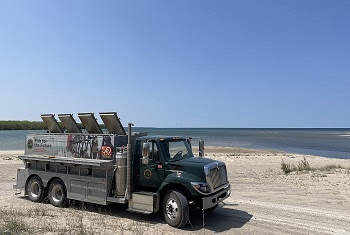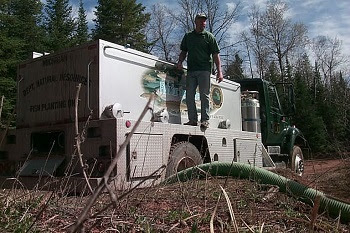

|
More than 269 tons of fish, eight different species, plus one hybrid, and a total of 9,335,410 individual fish – it all adds up to successful spring and summer stocking efforts by the Michigan Department of Natural Resources, and some great fall fishing for anglers.
Stocking is no small task. Over the course of 2,233 hours and more than 89,000 miles, DNR fisheries crews in 17 specialized trucks took 375 trips to stock fish at 705 different sites.
"We had excellent spring and summer stocking seasons that will bring significant benefits and fishing opportunities to Michigan anglers," said Ed Eisch, DNR fish production manager. "With the hard work and dedication of our staff, healthy, high-quality fish were reared and delivered to stocking sites in excellent condition. The numbers produced and stocked were right on target for most areas."
The number and type of fish produced varies by hatchery, as each location’s ability to rear fish depends on the source and temperature of the rearing water. In Michigan there are six state and two cooperative hatcheries that work together to produce the species, strain and size of fish needed for fisheries managers. These fish must then be delivered and stocked at a specific time and location to ensure their success.
|
Each hatchery stocked the following fish this spring and summer:
|
Included in this year’s total fish stocked were 2.7 million walleye spring fingerlings, fish that were reared in ponds by the DNR and tribal partners with extensive support provided by local sporting organizations. These fish were stocked at 90 inland lakes and rivers and Lake Michigan.
Fish stocking is a critical DNR activity. These efforts help support a Great Lakes fishery valued at more than $7 billion.
Fish are reared in Michigan's state fish hatcheries anywhere from one month to 1 ½ years before they are stocked.
It should be noted that some hatcheries will provide fish for a few additional stockings (consisting of brook trout, rainbow trout, coho salmon, walleye, lake sturgeon and muskellunge) to be made this fall. The lake sturgeon will come from the cooperative hatchery in Tower, Michigan, that is operated with Michigan State University.
The public is welcome at any of Michigan's state fish hatcheries to see firsthand the fish rearing process. For more information, visit Michigan.gov/Hatcheries.
Learn more about fishing opportunities, management and resources – including the DNR’s Fish Stocking Database, showing where many of these fish were stocked – at Michigan.gov/Fishing.
Contact: Jeremiah Blaauw, 906-235-7679